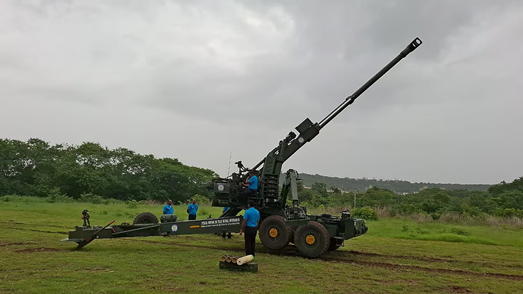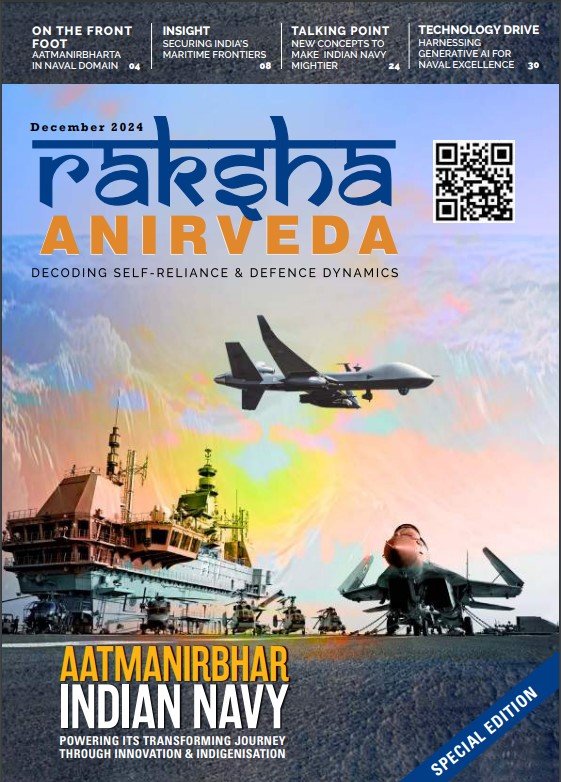If artillery is the god of war, then god appears in various avatars like towed artillery, truck-mounted artillery, and self-propelled artillery. Various artillery pieces can also be categorised as wheeled or tracked guns. Each form comes with its own advantages and limitations.
The recent reports that the Indian Army is set to begin trials of an indigenously developed truck-mounted artillery system – the mounted gun system (MGS) – and the application of different types of artillery systems, both modern and legacy, in the ongoing global conflicts, have led observers to conclude that the era of towed artillery is nearing its end. In this article, however, I aim to dispel this notion and argue that the Indian Army is, in fact, set to retain towed howitzers as the mainstay of its Regiment of Artillery.
The MGS basically features a variant of the indigenous Advanced Towed Artillery Gun System (ATAGS) with a smaller 23-litre chamber compared to the 25-litre chamber of the original towed howitzer, mounted on an 8×8 high mobility vehicle, and can operate in desert as well as high-elevation areas with shoot and scoot capability (see Figure 1). Its principal advantage lies in its high survivability due to its quick deployability, target engagement, and prompt redeployability to evade the enemy’s retaliatory fire.
The mounted gun system (MGS) is a variant of the indigenous Advanced Towed Artillery Gun System (ATAGS) with a smaller 23-litre chamber compared to the 25-litre chamber of the original towed howitzer, mounted on an 8×8 high mobility vehicle, and it can operate in desert as well as high-elevation areas with shoot and scoot capability
This is because at roughly 30 tonnes, with the vehicle and gun each weighing 15 tonnes, the system can travel at speeds of 60 kilometres per hour (kmph) and 90 kmph, in rough regions and plains respectively. Consequently, some analysts have prescribed an overhaul of Indian artillery to include such mobile systems as its mainstay, citing the following vulnerabilities and shortcomings of towed artillery during ongoing and recent global conflicts:
- Immobility: The immobile nature of towed artillery increases its probability of being engaged by enemy artillery or air strikes, particularly in dynamic combat situations where quick relocation is necessary.
- Counter-Battery Fire: 21st-century warfare has seen a rise in quick and accurate counter-battery fire capabilities, using advanced radar-guidance.
- Drones: The ongoing war in Ukraine has underscored the vulnerability of towed artillery to drone strikes, given their oft-slower redeployability and consequent susceptibility to hostile intelligence, surveillance, target acquisition, and reconnaissance (ISTAR) efforts.
- Deployment Challenges: Each towed artillery piece needs a different vehicle for transportation, which can impede quick relocation on the battlefield, causing delays in targeting the enemy and making such engagements less effective in rapidly evolving combat scenarios.
- Operational Footprint: Towed guns require cautious positioning to avoid detection, with their large size and longer setup time often hindering stealth and quick deployment, increasing their vulnerability to enemy ISTAR efforts.
To reduce the vulnerability of towed artillery on the battlefield, the Indian Army is focusing on developing towed artillery systems that can be rapidly repositioned, leveraging auxiliary power units for autonomous movement. Towed guns with reduced footprints are being designed to enhance concealment, making them harder to detect and target
While these are valid concerns, the following efforts to reduce the vulnerability of towed artillery and render them more survivable in the modern battlefield are often overlooked:
- Increased Mobility: The Indian Army is focusing on developing towed artillery systems that can be rapidly repositioned, leveraging auxiliary power units for autonomous movement.
- Concealment Techniques: Towed guns with reduced footprints are being designed to enhance concealment, making them harder to detect and target.
- Improved Targeting: Integration of precision-guided munitions and loitering munitions is being undertaken to enhance the accuracy and effectiveness of towed artillery systems, decreasing the need for prolonged exposure during engagements.
- Training and Tactics: Artillery crews are being trained to rapidly deploy and relocate towed guns, as part of tactics prioritising quick response and situational awareness.
Such efforts enable military forces to better secure their towed artillery systems and maintain operational effectiveness in varied combat scenarios.

Other reasons for the enduring role of towed artillery in the Indian Army include:
Lower Cost: Towed artillery systems are typically less costly to manufacture and maintain compared to self-propelled systems, enabling the maintenance of a larger artillery force.
Transferability: Often perceived as less mobile than self-propelled systems, towed artillery offers unique benefits in terms of transferability using helicopters (like the Chinook) and tactical transport aircraft (like the C-130J Super Hercules), while self-propelled and mounted guns would have to be disassembled to enable the same, and can only be transported by heavy transport aircraft (like the C-17 Globemaster III) without disassembly.
Towed artillery systems are less costly to manufacture and maintain compared to self-propelled systems, making it easier to maintain a larger artillery force. The development of ATAGS demonstrates the Indian Army’s focus on upgrading its artillery while reducing dependence on foreign original equipment manufacturers
Flexibility: Towed artillery grants operational flexibility in mountainous and other difficult terrain as well as areas inaccessible by road, given their amenability to aerial transfer.
Indigenisation and Modernisation: The development of ATAGS to replace older towed artillery, such as the Bofors, demonstrates the Indian Army’s focus on upgrading its artillery while reducing dependence on foreign original equipment manufacturers (see Figure 2).
The Indian Army’s towed artillery systems are tailored to overcome hurdles posed by diverse terrains, including mountainous and rugged landscapes. Hence, the operational requirement for artillery in the Indian Army is hinged on a balance between firepower and mobility.
The Indian Army’s Field Artillery Rationalisation Plan aims to replace older, smaller calibre guns. In this, the ATAGS is expected to provide the Indian Army with crucial firepower amid heightening regional security challenges. So, the towed system seems well-positioned to secure its place at the core of India’s Regiment of Artillery over the coming decade
The development and production of the ATAGS have been pursued collaboratively between India’s Defence Research and Development Organisation, Bharat Forge, and Tata Advanced Systems Limited. The system’s design and production have been executed in India, with a major share of components being indigenous, including the barrel, breech mechanism, recoil systems, and fire control systems. This initiative is part of the Indian Army’s Field Artillery Rationalisation Plan, which aims to replace older, smaller calibre guns with contemporary, high-performance guns. As the bedrock of this endeavour, the ATAGS is expected to provide the Indian Army with crucial firepower along sensitive border areas, especially amid heightening regional security challenges. The towed system, therefore, seems well-positioned to secure its place at the core of India’s Regiment of Artillery over the coming decade and beyond.
The writer is an independent researcher with publications spanning diverse fields, including terrorism and counter-terrorism, foreign policy, climate finance, microfinance, maritime security, corporate finance, and industrial organisation.






